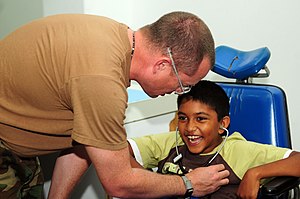
Cerebral palsy

Cerebral palsy (CP) is a group of permanent movement disorders that appear in early childhood. Signs and symptoms vary among people and over time. Often, symptoms include poor coordination, stiff muscles, weak muscles, and tremors. There may be problems with sensation, vision, hearing, swallowing, and speaking. Often, babies with cerebral palsy do not roll over, sit, crawl or walk as early as other children of their age. Other symptoms include seizures and problems with thinking or reasoning, which each occur in about one third of people with CP. While symptoms may get more noticeable over the first few years of life, underlying problems do not worsen over time. Cerebral palsy is caused by abnormal development or damage to the parts of the brain that control movement, balance, and posture. Most often, the problems occur during pregnancy; however, they may also occur during childbirth or shortly after birth. Often, the cause is unknown. Risk factors include preterm birth, being a twin, certain infections during pregnancy such as toxoplasmosis or rubella, exposure to methylmercury during pregnancy, a difficult delivery, and head trauma during the first few years of life, among others. About 2% of cases are believed to be due to an inherited genetic cause. A number of sub-types are classified based on the specific problems present. For example, those with stiff muscles have spastic cerebral palsy, those with poor coordination have ataxic cerebral palsy and those with writhing movements have athetoid cerebral palsy. Diagnosis is based on the child's development over time. Blood tests and medical imaging may be used to rule out other possible causes. CP is partly preventable through immunization of the mother and efforts to prevent head injuries in children such as through improved safety. There is no cure for CP; however, supportive treatments, medications and surgery may help many individuals. This may include physical therapy, occupational therapy and speech therapy. Medications such as diazepam, baclofen and botulinum toxin may help relax stiff muscles. Surgery may include lengthening muscles and cutting overly active nerves. Often, external braces and other assistive technology are helpful. Some affected children can achieve near normal adult lives with appropriate treatment. While alternative medicines are frequently used, there is no evidence to support their use. Cerebral palsy is the most common movement disorder in children. It occurs in about 2.1 per 1,000 live births. Cerebral palsy has been documented throughout history, with the first known descriptions occurring in the work of Hippocrates in the 5th century BCE. Extensive study of the condition began in the 19th century by William John Little, after whom spastic diplegia was called 'Little's disease'. William Osler first named it 'cerebral palsy' from the German zerebrale Kinderlähmung (cerebral child-paralysis). A number of potential treatments are being examined, including stem cell therapy. However, more research is required to determine if it is effective and safe. Cerebral palsy is defined as 'a group of permanent disorders of the development of movement and posture, causing activity limitation, that are attributed to non-progressive disturbances that occurred in the developing fetal or infant brain.' While movement problems are the central feature of CP, difficulties with thinking, learning, feeling, communication and behavior often co-occur, with 28% having epilepsy, 58% having difficulties with communication, at least 42% having problems with their vision, and 23–56% having learning disabilities. Muscle contractions in people with cerebral palsy are commonly thought to arise from overactivation. Cerebral palsy is characterized by abnormal muscle tone, reflexes, or motor development and coordination. The neurological lesion is primary and permanent while orthopedic manifestations are secondary and progressive. In cerebral palsy unequal growth between muscle-tendon units and bone eventually leads to bone and joint deformities. At first deformities are dynamic. Over time, deformities tend to become static, and joint contractures develop. Deformities in general and static deformities in specific (joint contractures) cause increasing gait difficulties in the form of tip-toeing gait, due to tightness of the Achilles tendon, and scissoring gait, due to tightness of the hip adductors. These gait patterns are among the most common gait abnormalities in children with cerebral palsy. However, orthopaedic manifestations of cerebral palsy are diverse. The effects of cerebral palsy fall on a continuum of motor dysfunction, which may range from slight clumsiness at the mild end of the spectrum to impairments so severe that they render coordinated movement virtually impossible at the other end of the spectrum. Although most people with CP have problems with increased muscle tone, some have normal or low muscle tone. High muscle tone can either be due to spasticity or dystonia. Babies born with severe cerebral palsy often have an irregular posture; their bodies may be either very floppy or very stiff. Birth defects, such as spinal curvature, a small jawbone, or a small head sometimes occur along with CP. Symptoms may appear or change as a child gets older. Babies born with cerebral palsy do not immediately present with symptoms. Classically, CP becomes evident when the baby reaches the developmental stage at 6 to 9 months and is starting to mobilise, where preferential use of limbs, asymmetry, or gross motor developmental delay is seen. Drooling is common among children with cerebral palsy, which can have a variety of impacts including social rejection, impaired speaking, damage to clothing and books, and mouth infections. It can additionally cause choking.
